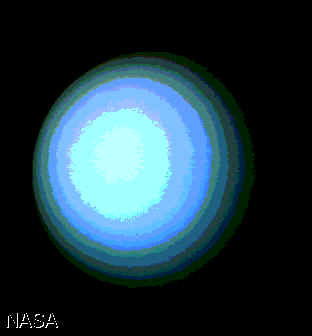|
|
|

Uranus (planet), major planet in the solar system, equivalent in brightness to a sixth-magnitude star and represented by the symbols
Ù and ®. It ranks seventh in order of distance from the sun, revolving outside the orbit of Saturn and inside the orbit of Neptune . Uranus was accidentally discovered in 1781 by the British astronomer Sir William Herschel and was originally named the Georgium Sidus (Star of George) in honor of his royal patron King George III of Great Britain. The planet was later, for a time, called Herschel in honor of its discoverer. The name Uranus, which was first proposed by the German astronomer Johann Elert Bode, was in use by the late 19th century.Uranus has a diameter of 51,120 km (31,771 mi), and its mean distance from the sun is 2.87 billion km (1.78 billion mi). Uranus takes 84 years for a single revolution, or orbit, and 17 hr 15 min for a complete rotation about its axis, which is inclined 98° to the plane of the planet's orbit around the sun. Uranus's atmosphere consists largely of hydrogen and helium, with a trace of methane. Through a telescope the planet appears as a small, bluish-green disk with a faint green periphery. Compared to the earth, Uranus has a mass 14.5 times greater, a volume 67 times greater, and a gravity 1.17 times greater. Uranus's magnetic field, however, is only a tenth as strong as earth's, with an axis tilted 55° from the rotational axis. The density of Uranus is approximately 1.2.
In 1977, while recording the occultation of a star behind the planet, the American astronomer James L. Elliot discovered the presence of five rings encircling the equator of Uranus. Named Alpha, Beta, Gamma, Delta, and Epsilon (starting from the innermost ring), they form a 9400-km- (5840-mi-) wide belt extending to 51,300 km (31,860 mi) from the planet's center. Four more rings were discovered in January 1986 during the exploratory flight of Voyager 2.
In addition to its rings, Uranus has 15 satellites (the last 10 discovered by Voyager 2); all revolve about its equator and move with the planet in an east-west direction. The two largest moons, Oberon and Titania, were discovered by Herschel in 1787. The next two, Umbriel and Ariel, were found in 1851 by the British astronomer William Lassell. Miranda, thought before 1986 to be the innermost moon, was discovered in 1948 by the American astronomer Gerard Peter Kuiper.

For more information on Uranus, Please visit the following webistes:

[Hit Counter]
